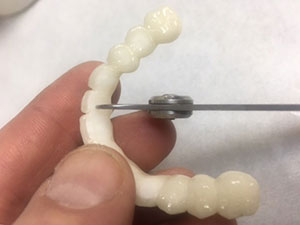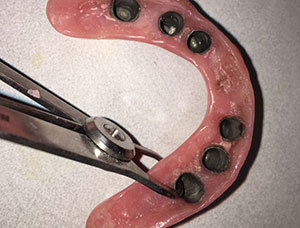
Implant restorations made in the United States exceed 5 million units each year, with these fixtures placed by only 10% of dentists nationwide. Many implant fixtures consist of single-unit restorations.
But in recent years, the use of four to six implant fixtures to retain a cemented complete or partial arch reconstruction has become the desired treatment of choice for fully or partially edentulous patients, compared to removable prosthetics.
Dentists now can take advantage of a simple method for memorializing the screw access location and recording it in the patient’s record with a photograph. Also, laboratory technicians can avail themselves of another method to indicate locations for screw access.
Discussion
When screw-retained prostheses become loose, the locations of the screw access chambers are apparent, and removal of the prosthesis and evaluation of individual implant fixtures and abutments are easily accomplished. When cemented restorations become loose, a potentially more difficult situation arises.
 |
| Figure 2: The location of the abutment is apparent, but not the location of the screw head. |
Restorations supported by cement-retained dental implants for individual teeth or multiple teeth require the utilization of an implant fixture, a custom fabricated or manufacturer prefabricated abutment, and the dental prosthesis. Once placed, an implant-supported dental prosthesis can provide excellent service for patients.
However, the restorative dentist faces a conundrum when a patient returns with a chief complaint of a loose implant-supported prosthesis. Experienced clinicians quickly realize that the patient is usually complaining of either the implant abutment or prostheses and not the actual implant fixture being loose. Implant fixtures do fail, though, necessitating customized care.
Frequently, loose dental implant prostheses may be removed with either finger pressure or by utilizing a Morrell or pneumatic crown and bridge remover, permitting the clinician to address the issue and replace the prosthesis uneventfully. Yet there are instances where a prosthesis firmly adheres to the remaining abutment or abutments and a crown remover could be potentially harmful to remaining implant fixtures or prostheses.
A loose implant prosthesis is the result of either a loose screw retaining one or more implant abutments to the implant fixtures or the implant prosthesis cement washing out under one or more, but not all, of the implant prosthesis’ retainers. A prosthesis that is retained via screws and screw access channels is easily addressed. The clinician simply locates and accesses the screws to make the necessary adjustments. When a cement-retained prosthesis has partially dislodged, though, the clinician may have to create access openings through the prosthesis to remove abutment retaining screws, freeing the prosthesis from the implants.
 |
 |
| Figure 3: A crown gauge caliper is used to indicate the location of the screw access. | Figure 4: The long end of the crown gauge caliper holds the position of the actual location of the screw access. |
 |
 |
| Figure 5: Articulating paper marks indicate the location of the screw head. | Figure 6: Indelible marker indicates the location of the screw head. |
 |
 |
| Figure 7: Articulating paper marks indicate access to the screw head. | Figure 8: Screw-head access from the facial direction is especially important for maintaining the longevity of the prosthesis. |
The cement-retained prosthesis does not provide any indication clinically to the location of screws or to the best entry point to locate a screw head to make adjustments. A clinician looking for screw access is unaware, especially in the anterior esthetic zone, if creating an access facially or lingually/palatally will be best. Generally, clinicians will create an access on the lingual/palatal first to avoid damaging aesthetics, knowing that they may irreparably damage abutment and prosthesis longevity.
A restoration that has completely dislodged from the abutments or fixtures is easily evaluated, adjusted, and replaced. However, loose single cemented or multi-unit cemented restorations that remain cemented to one or more abutments make it difficult for the clinician to discover the head of the retaining screw. The clinician faces the difficult task of addressing the removal of the loose prosthesis without causing damage to evaluate implant fixtures and abutments for looseness and health.
The clinician must remove the prosthesis to properly evaluate implant fixtures and abutments prior to recementation. It is necessary to discover the screw head to remove the prosthesis, evaluate the health of the implant or restoration, and then retighten or replace the screw and maintain restoration and implant health.
Methods
These procedures will make future adjustments to dental implant prosthesis screws less stressful and more time efficient for the clinician and comfortable for the patient.
Prior to “final” cementation, with the prosthesis on the benchtop, it is clear to see that there are no markings or indication of screw access (Figure 1). The intaglio surface (Figure 2) reveals the locations of the custom fabricated implant abutments but not the screw access locations.
A crown gauge caliper is used to indicate the screw location as the two tines come together perfectly on both the intaglio and porcelain surfaces. It is used with the longer tine within the retainer at the location of the screw chamber and the shorter tine on the occlusal, incisal, labial, palatal, or lingual surface (Figures 3 and 4). The tines are closed to indicate the perfect location for creating an access opening, if needed.
Once the clinician is confident the location is correct, articulating paper is placed under the shorter tine, and a mark is created. Once all locations are discovered, a photograph is exposed and placed in the patient’s record for future reference (Figures 5, 6, 7). Especially important are those screw heads that emerge on the facial in the aesthetic zone (Figure 8). A clinician attempting to discover a screw head from the lingual/palatal only to discover that it emerges on the facial would destroy the prosthesis prior to its discovery, necessitating a new prosthesis.
To memorialize screw access location indefinitely, the laboratory technician should be instructed to place a spot of contrasting porcelain shade, such as stain, in the location over the screw access. The stain should be placed to the depth of the metal, zirconia framework or deep enough within the aesthetic overlay so it won’t be removed during occlusial adjustment or polishing procedures and not merely placed superficially so adjustments may remove the mark. This would benefit these patients and future dentists should these patients move to another location or experience an emergency while away from their usual dentist.
Dr. Feit received his dental degree from New Jersey Dental School (currently Rutgers School of Dental Medicine) and completed the postgraduate specialty program in prosthodontics at Boston University’s Goldman School of Dental Medicine and Maxillofacial Prosthetics at Memorial Sloan Kettering Cancer Center in New York. In addition to maintaining a private practice in Tenafly, New Jersey, he is a faculty member at the Rutgers School of Dental Medicine, past president of the New Jersey Section of the American College of Prosthodontists, and past president of the Bergen County Dental Society. He also has presented at the Greater New York Dental Meeting and authored a number of articles. He can be reached at danfeit3@gmail.com.
Related Articles
Key Implant Positions: Treatment Planning Using the Canine and First Molar Rules
Implant Treatment Complications











